History

The original 17 bells of the Hopeman Memorial Chime are displayed on the Eastman Quadrangle before being installed in the Rush Rhees Library tower in 1930.
Bells have rung on campus since the dedication of Hopeman Chime in 1930 as a living memorial for Arendt Willem Hopeman, a ringing celebration of public music and Dutch culture. The Hopeman family were specialists in shipbuilding, carpentry, and engineering.
The original bells were cast at the Meneely Bell Foundry in Watervliet, New York at a time when precision large bell tuning was being developed in America.
Two Petit and Fritsen bells were added to the chime in 1956.
Hopeman Chime bells were played first by a succession of faculty starting with beloved English professor John Rothwell Slater, later by students forming the Bellman Society in 1954.
When repairs became necessary for the heavy chime, installation of a lighter weight new carillon was thought to be a wiser financial choice than repair.
The objective was to gain a substantial reduction in vibration from 16+ tons to 3.5 tons, as recalled by David Caldwell. The Hopeman family approved the purchase and assisted with the necessary change out of girder attachments to support the new instrument. The carillon was purchased from Eijsbouts Bellfoundry Ltd. of Asten, Netherlands. The Department of History allows for viewing the original documentation of the purchase.
Photo Source - Edwin Tan 2012
Comparing the Hopeman Chime to the Hopeman Carillon:
- Hopeman Chime 1930 dedication, largest single bell in the chime weighed 7,800 pounds, total weight was 16-23 tons following the 1956 bell increase, set not completely chromatic, electronic keyboard.
- Hopeman Carillon 1973 dedication, largest single bell in the carillon weighs 1411 pounds, total weight 6,668 pounds, 4 octaves of the set are chromatic, touch sensitive baton and pedal keyboard console.
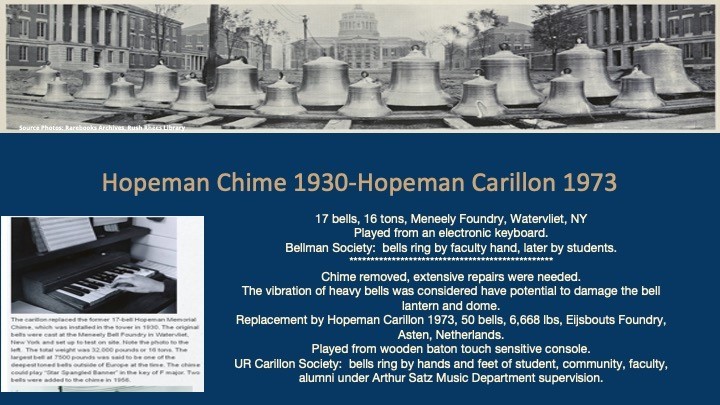
(Source - Rarebooks Archive)
Of the removed Meneely bells, one was given to the Hopeman family as a keepsake, later sold in an estate auction.
The 6 smallest Meneely bells went to Christ Church, 141 East Avenue, Rochester, together with an Eijsbouts treble (total 7) where they play automatically on the quarter hour.
The larger bells had to be cut in pieces to be safely removed through the building elevator. Their bronze was shipped to Europe to be reformed into a new bell set. The value of the bronze provided credit against the overall purchase of the new Eijsbouts bells.
The Eijsbouts Bellfoundry, Ltd. carillon bells replacement for chime were cast in Asten, Netherlands. Though the number of carillon bells is much bigger than the original chime, it is also much lighter. The carillon’s 50 bells cover more than four octaves yet fit into the space left by the removed chime.
The Hopeman Memorial Carillon was dedicated in a special concert on December 9, 1973 performed by Arie Abbenes.

(Source - Rarebooks Archive)
The Hopeman Memorial Carillon was dedicated in a special concert on December 9, 1973 performed by Arie Abbenes.
Weather was so cold and snowy the bells had to be swept off by Facilities during the concert to keep bells from muffling under a blanket of snow according to Abbenes.


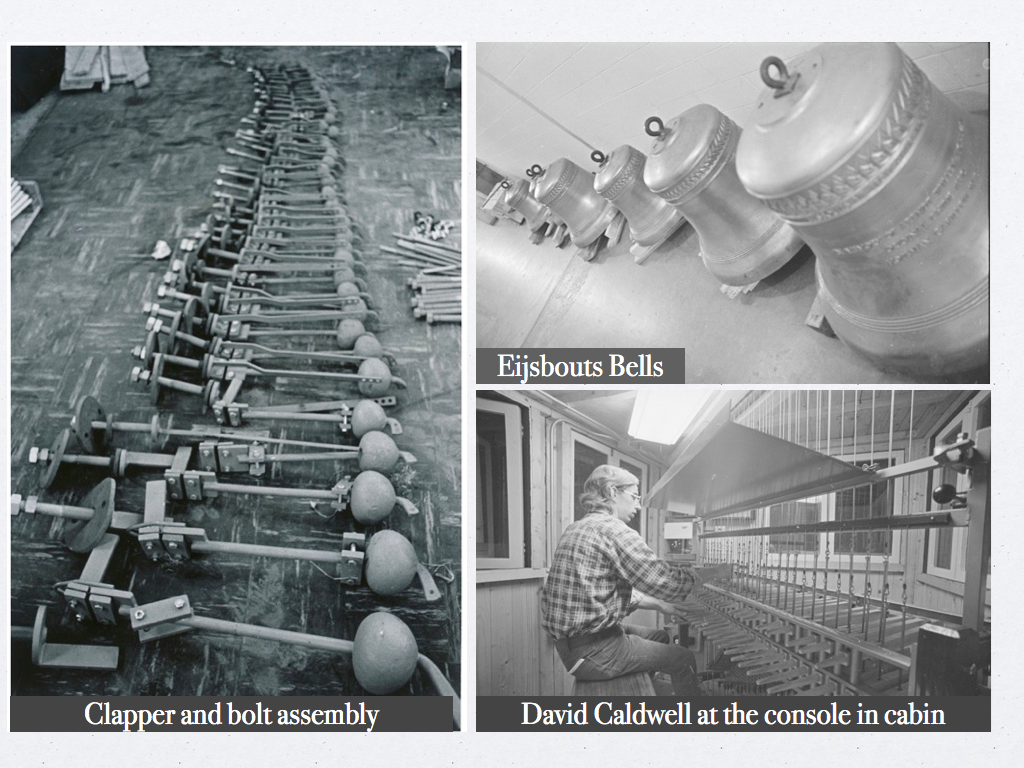
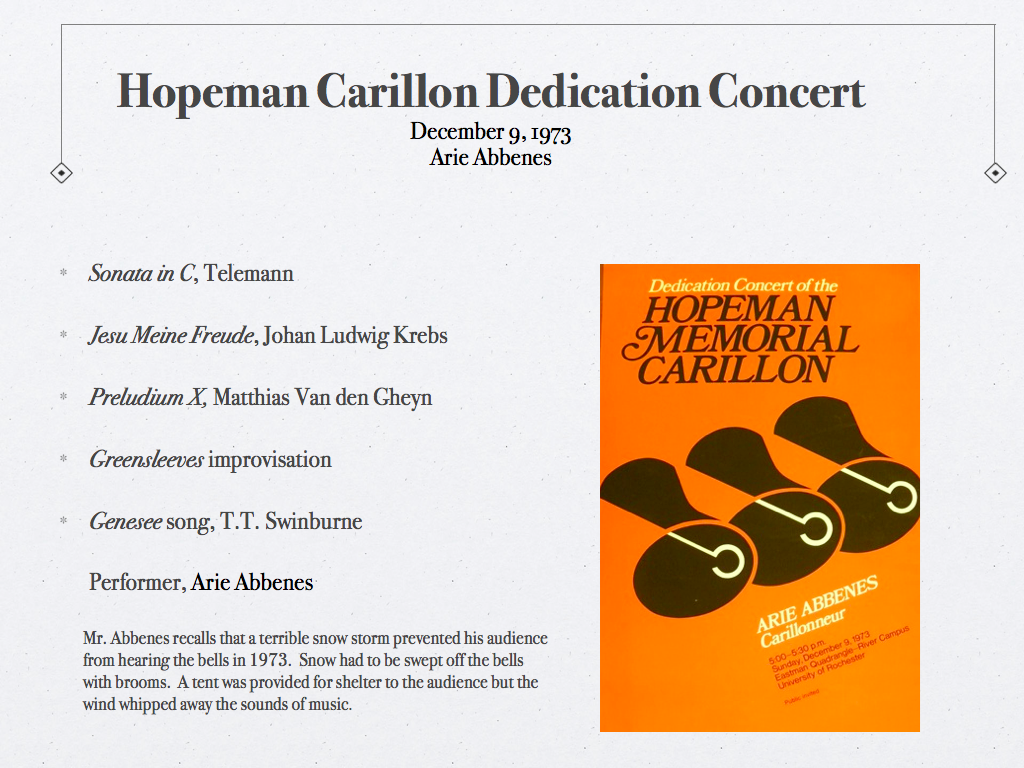
Source of photos: Rarebooks archives, used with permission.
Announcements of the Carillon Dedication Concert:
- Campus Times article November 28, 1973, “Free Concert to Honor the Dedication of Carillon”
- Campus Times October 28, 1974, “The Bells Toll for Thee”
Bellman and Carillonists
The first University bellman was John Rothwell Slater, chairman of the English department, who served as bellman from 1930 to 1940. Alumnus and honorary trustee Robert Metzdorf took over from 1940 to 1949 while serving on the staffs of Rush Rhees Library and the English department.
Students served as bellmen from 1949 to 1953, when the Bellman Society was founded to provide undergraduate students opportunities to play the chime. From 1930 to 1973, while the chime was in service, 98 individuals performed as bellmen. The 2-octave keyboard was electronic.
The first person to play the new carillon was Dutch carillonist Arie Abbenes, who performed at the dedication concert in 1973 and stayed on campus for several weeks to help train new carillonists.
Bellman Society transitioned to UR Carillon Society. The carillon became sponsored by the River Campus Music Department played by a series of students, staff, and faculty across the years.
From David Caldwell:
“I was a member of the student Bellman Society starting in the fall of 1971, played the chime until it was replaced in 1973, and played the carillon until mid-1975. ...I returned to Rochester in the summer of 1978, became the University Carillonist that fall and continued until late 1989.”
Carillon students play manually from a touch sensitive console, quite differently from the former chime.
Student and guest carillonists perform on the instrument throughout the year, and an electronic system is programmed to chime on the quarter hour. The traditional "Westminster Quarters" (or "Big Ben" chime) was replaced during the University's sesquicentennial celebration in 2000 by the "Rochester Quarters," composed by former Department of Music professor Daniel Harrison. (The "Westminster Quarters" returned in 2004.)
Hear the "Rochester Quarters" as the clock strikes noon.
Hopeman Family
The original Hopeman Memorial Chime was given to the University in memory of Arendt W. Hopeman by his daughter and two sons in 1930. Arendt Hopeman founded A.W. Hopeman Builder in 1869. The company served as the general contractor of the River Campus from 1927 to 1930, and also built the Eastman Theatre, Eastman School of Music, Eastman Kodak headquarters, and other Rochester landmarks. The Hopeman Engineering Building on River Campus is also named for him.
His daughter Margaret Hopeman was a 1903 alumnus of the University and received her master of arts degree from Rochester in 1906. His son Albert A. Hopeman served as president of the newly named A.W. Hopeman and Sons, as well as chairman of the board of Hopeman Brothers, a shipbuilding jointer firm. His brother Bertram Hopeman served as treasurer of Hopeman Brothers.
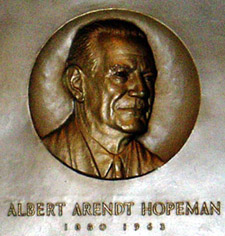
Image is of Albert Arendt Hopeman, son of Albert W. Hopeman.
Refurbishments
With Your Generous Support to the Hopeman Carillon Fund
- 2021 Updates and maintenance to the sound system of the carillon cabin were completed. Live stream equipment was added to the tower room.
- 2019 The University of Rochester Carillon Society has been able to purchase a new adjustable bench that will assist carillonists, from novices to masters, practicing in the tower for decades to come. The bench will seat up to a trio of performers. Thank you for your support!
- 2018 Spurrier practice instrument has been refurbished with new tone bars and transmission system. Thank you, donors to the Hopeman Carillon Fund!
- 2017 Refurbishment of the tower instrument included new bell bolts and headpiece, new clappers, springs, and stabilizers to the wires so they are less likely to jump their track.
The initial phase of the restoration began on August 24, 2017 and was completed on August 29, 2017 (see a photo essay here). The 32 smaller bells were removed and loaded on a trailer to have their clappers rebuilt/refitted in Meeks & Watson’s workshop in Ohio. The largest of these "small" bells was 12–14” in diameter and about 150 pounds. The 18 largest bells were too large to move. The clappers, however, were removed and replaced with new clappers.
In September, Meeks & Watson returned to replace the now-refurbished smaller bells. After some adjustments and a return trip, the bells are ringing again. And they sound fantastic!
The next chapter in the restoration saga will be upgrades to the carillon keyboard, a new "umbrella system" (which prevents water that collects at the base of the tower from leaking into the cabin—and on the keyboard—should the water rise above a certain level) and refurbishment repairs to the bell lantern and 1930’s era chime girders holding the weight of the carillon.
Future Projects
The bell lantern edifice and carillon are supported by 1930’s construction era girders, brick, and roofing. Nearing the 100 years mark these need repair and restoration. Although it looks small from the ground the bell lantern is several stories in height.
Necessary carillon instrument updating replacements include umbrellas (avoid water penetration) and adjusting turnbuckles on the carillon console.
UMBRELLAS
Definition: A protective cover at the base of the wire for the purpose of shedding water before the wire enters through the chimney to the lower cabin and console.
ADJUSTING TURNBUCKLES
Definition: A turnbuckle device located immediately above each manual key. It allows the performer to compensate for changes in wire length due to temperature changes, so that the clapper is always in the correct position, neither too close to nor too far from the bell.
Present turnbuckles are infinitely adjusting but do not lock to hold an adjustment throughout a concert. Frequent readjustments must be made.
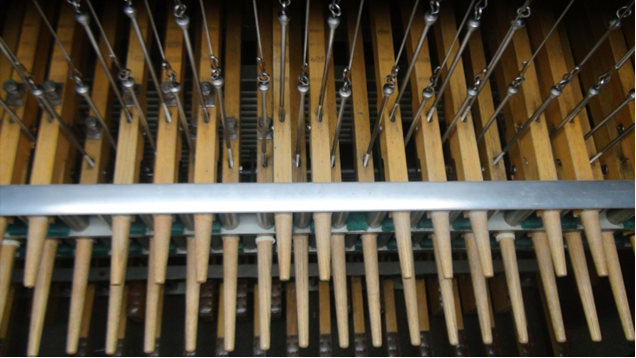
If you wish help with the restoration funding, your charitable contribution is most welcome. And thank you to all those already supporting the restoration via donations to the Hopeman Carillon Fund.
That being said … let the bells ring out!

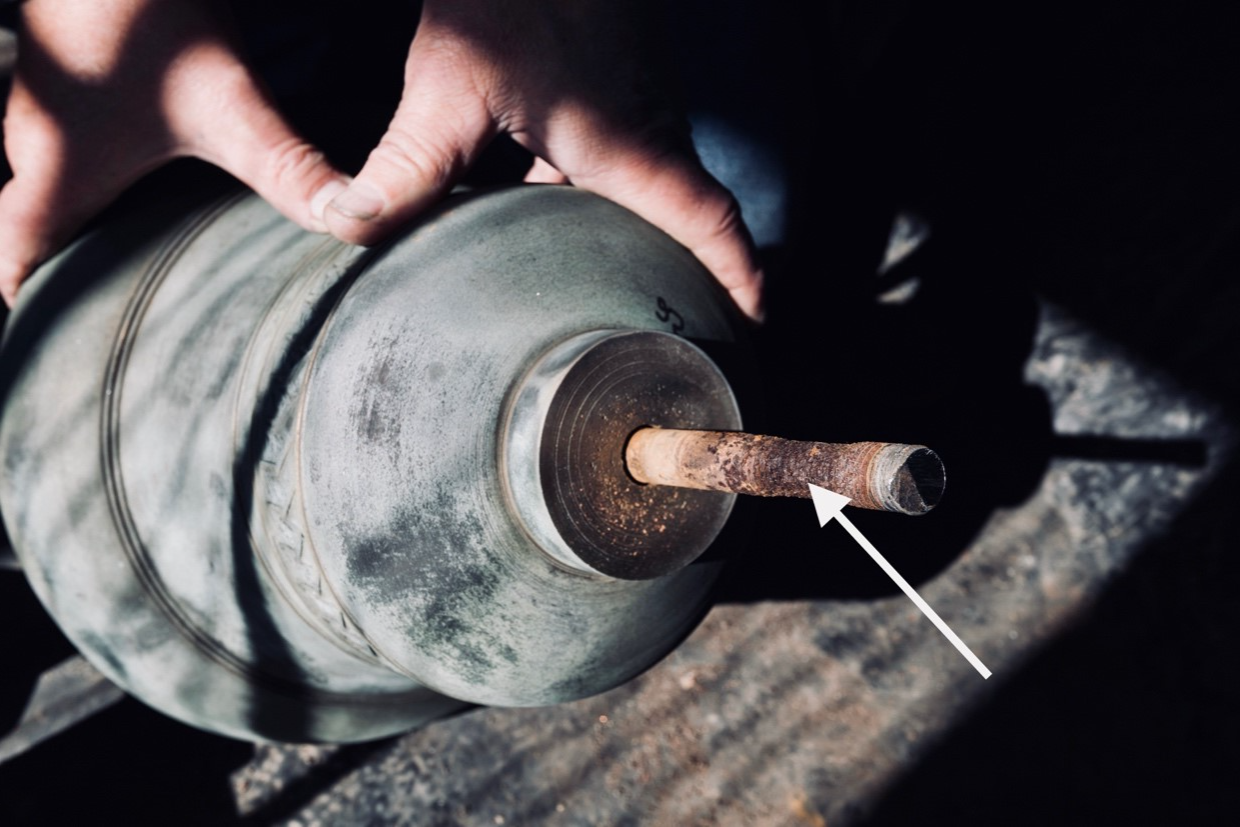
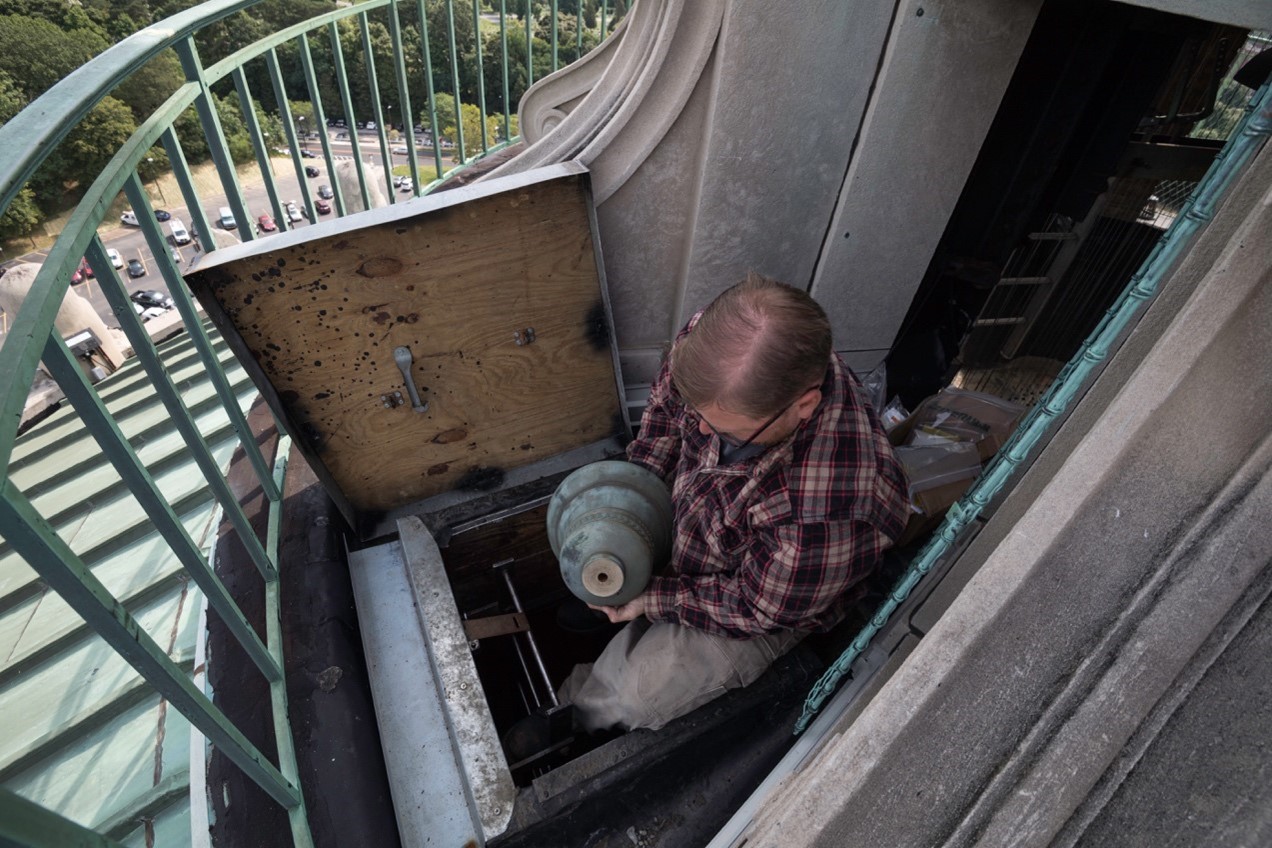
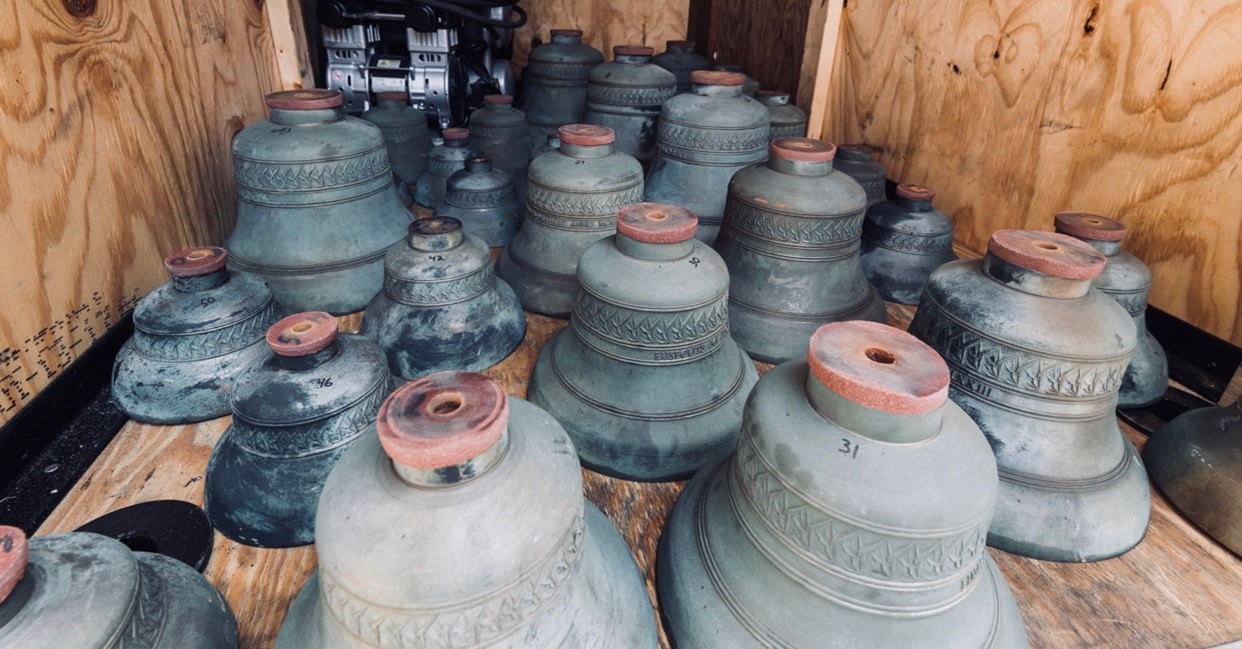
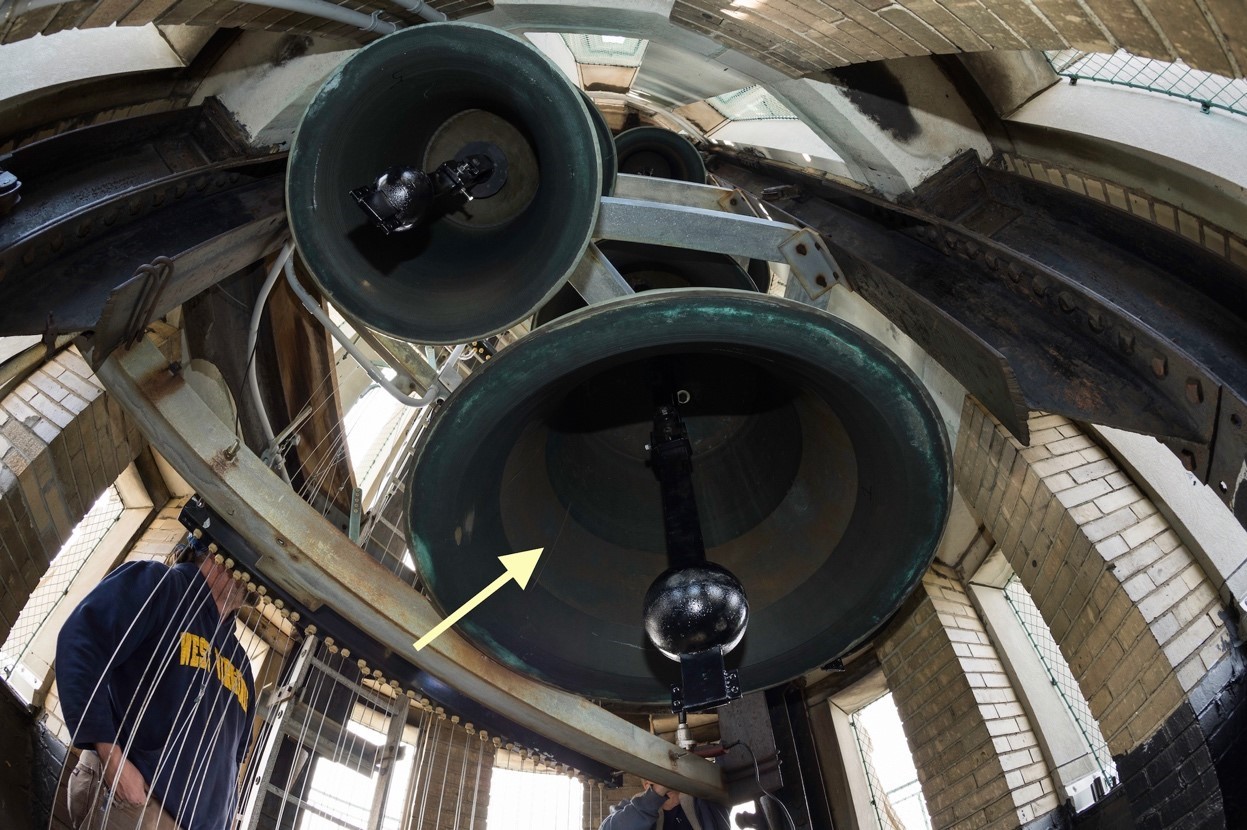
Past Articles
Victims of 9/11 attacks honored at U of R
Celebrating Women, Music, and Culture
Past Performances
Claire Janezic, Class of 2021, Performs "Lament & Alleluia", composed by Alice Gomez, on carillon at the University of Rochester in February, 2021.
The Genesee (1895) - University Alma Mater (2:14): by Thomas T. Swinburne, Class of 1892; arrangement by Herve D. Wilkins, Class of 1866; performed on the Hopeman Memorial Carillon by Daniel Harrison.
Rochester Quarters (2000) (0:53): by Daniel Harrison, former Department of Music professor. Composed in honor of the University's sesquicentennial celebration. read more about the theory of the Rochester Quarters
Livestream archival video of Joey Brink concert, in duet with Vera (July 6, 2015)
Opening theme to Harry Potter (4:48): played by Jeff Le, Class of 2007. Clip from February of 2008.
Carillon concerts ring in new semester, Campus Times, October 2021
500 bells to remember 500,000 people lost to COVID-19WXXI News, Ferbruary 2021
Winning the 'Olympics' of the carillon Newscenter, July 2019
The Immovable, But Beautiful, Hopeman Carillon WXXI News, August 2015
Connections WXXI with Evan Dawson, July 2015 "Arts Friday—The Summer Festivals"
CLASSICAL | University of Rochester Carillon Rochester City Newspaper, July 2015
Photos
Adam Fenster photography collections of Hopeman Carillon activities:
